 Research Article
Research Article
Workplace Epidemic Prevention and Control and Return to Work Measures and Difficulties, Based on a Questionnaire Survey Analysis of Employees in the Road and Bridge Industry
Jiefang Huang1, George Zhuang2, Chao Yang1 and Jiujiang Zhu1*
1School of Civil Engineering and Architecture, Wuyi University, China
2Plains Commerce Bank, Sioux Fall, South Dakota, USA
Jiujiang Zhu, School of Civil Engineering and Architecture, Wuyi University, China.
Received Date: February 22, 2022; Published Date: February 28, 2022
Abstract
At the beginning of 2020, the novel coronavirus outbreak occurred in many places in China, and its impact on all types of enterprises continues. Under the premise of epidemic prevention and control, the resumption of work and production of the major road and bridge enterprises is an important part of the response to this current, complex situation. In response, the Joint prevention and control mechanism of The State Council enacted the requirement for the relevant local departments to coordinate epidemic prevention and control with the restoration of economic and social order in accordance with the law. As an important force in the construction industry, road and bridge enterprises continue to increase their rate of resumption of work, but there are many difficulties to deal with in the process of resuming work. Based on China’s road and bridge enterprises, this paper will analyze the difficulties and solutions from the dual elements of epidemic prevention and control and resumption of work and production.
Keywords: Epidemic prevention and control; Road and bridge enterprises; Difficulties in resuming work and production
Introduction
Research background
Following the outbreak of the novel Coronavirus 2019 (COVID-19) pneumonia in Wuhan, Hubei province in December 2019, there have been a series of COVID-19 outbreaks in various parts of China. To prevent the spread of the disease, a series of relevant policies have been introduced and implemented, as have various prevention and control measures.
The situation of COVID-19 in China: In late January 2020, a COVID-19 epidemic broke out in Wuhan and spread across our country [1]. It continued to spread nationwide in February. At the beginning of March, the proportion of new cases gradually decreased (Table 1).
Table 1: The Scale change of COVID-19 in China.
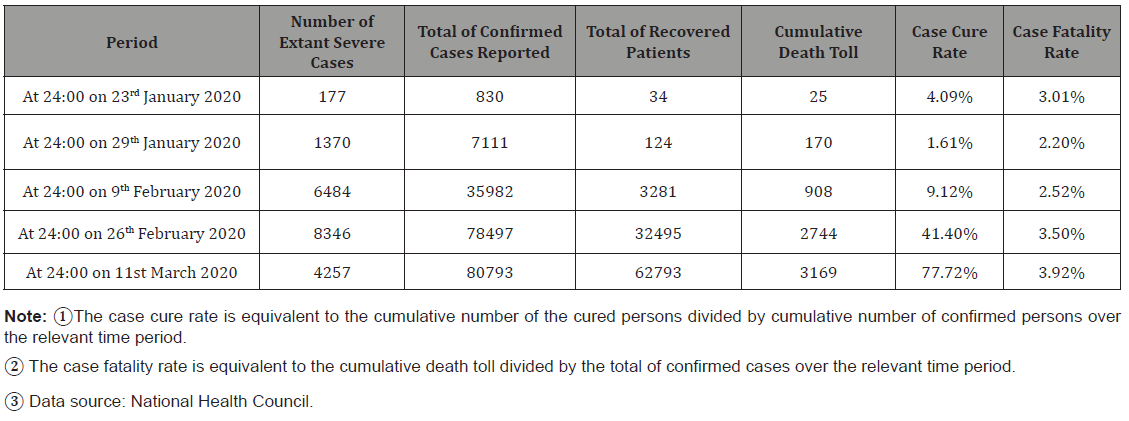
Policies and measures in China:
a. Transportation: In order to reduce the risk of further spread
of the epidemic, Wuhan took measures to shut down the city
and temporarily closed the outbound exits on January 23 [2].
Other parts of the country also took partial road closures and
traffic controls to cut off the spread of the virus. Since January
25, trains which ran throughout China had been temporarily
suspended or had their operating range adjusted.
b. Control and prevention: At the end of January 29, all the
provinces of China had launched a Level One Response in
response to this major public health emergency.
c. Resuming work and production: Because the specific
situation of the COVID-19 epidemic is different in different
regions, China has adopted a strategy of identifying guidance
and implementing policies by region to coordinate epidemic
prevention and control with the goal of a restoration of
economic and social order [3]. According to the notice from
local governments, many were not allowed to resume work
until 24:00 on February 9, except for those necessary for
epidemic prevention and control, safeguarding urban activity,
construction of key projects, and those related to various
matters concerning the national economy and peoples’
livelihoods.
The construction sites in Tianjin City, except for those that
could not be stopped due to construction safety requirements
and those related to epidemic prevention and control and
emergency and restoration projects, were all postponed [4].
Research purpose
An important issue in China today, COVID-19 still has an outsize impact on all sectors of life. Driven by my area of study, namely traffic engineering (road and bridge), I will focus on the impact of the epidemic on China’s road and bridge enterprises, as well as the difficulties and measures taken in the process of their resumption of work and production. The purpose of this investigation was to increase my understanding of road and bridge enterprises and to use more professional knowledge to apply to the current epidemic situation for the purpose of putting forward some new views and actionable suggestions.
Research
Research overview
The scope of data collection for this paper was mainly journal literature and news reports. We conducted an advanced search on CNKI, taking “Road and bridge enterprises” as the keywords, together with “COVID-19 prevention and control” and “measures for the resumption of work and production”, but the result of the literature search was insubstantial. Considering that road and bridge enterprises account for a small proportion of all industries, the author changed the keyword “road and bridge enterprises” to “enterprises”, along with “COVID-19 prevention and control” and “measures to resume work and production”, resulting in about 80 articles. Using the same keywords to search on the official websites of major domestic media and the official websites of road and bridge enterprises, the number of articles found was much larger.
Content analysis
Comparative analysis of COVID-19 and SARS: Within 30 days of the outbreak of COVID-19 in China, the cumulative number of people infected surpassed that of SARS (Severe Acute Respiratory Syndrome) in 2003, indicating that COVID-19 is significantly more contagious than the SARS virus. Su Yiren, a virus expert from Taiwan, China, said, “The higher the infectivity of the virus, the lower the fatality rate actually is” [5]. According to official data, the fatality rate of SARS in China in 2003 was about 6.55%. That of COVID-19 in China was about 3.92% as of 24:00 on March 11. Indeed, the fatality rate of COVID-19 is relatively low. However, its high infectivity is still a major a difficulty in the prevention and control of COVID-19 epidemics. At present, human-to-human transmission and infection among medical workers have occurred, and there is a certain range of community transmission [6].
Present situation and outlook:
a. Road and bridge enterprises: In recent years, transportation, as a driving force of economic development, has developed rapidly with the support of the Chinese government. At present, the output value of the construction industry in China is increasing year by year, and the employment opportunities provided by road and bridge enterprises are also increasing, creating valuable new standards for society [7]. Therefore, road and bridge enterprises are one of the most indispensable parts of China’s modern construction industry, as well as an important force to stimulate domestic demand, improve national employment rates, and maintain the stability of socioeconomic processes and of infrastructure.
The profits of the combined road and bridge enterprises are meager. With the gradual integration of China’s road and bridge construction industry into the global economy and the gradual opening of the road and bridge construction market, road and bridge enterprises face a bigger potential market while competing with foreign road and bridge enterprises for the same global market [7].
b. Road and bridge engineering:
1. Road Engineering: According to data from 2001 to 2010, China’s new added mileage of railways and highways show a steady growth trend in which the development rate of expressways is faster than graded roads. According to the National 11th Five-Year Plan and National Expressway Network Plan, we know that China has invested greatly in highway construction and has relatively good development prospects for the same (Table 2).
Table 2: National Highway Investment During the 11th Five-Year Plan Period.

2. Bridge Engineering: Bridges, as artificial structures which helps us to across rivers, seas, deep valleys and other obstacles, play an important role in China’s transportation infrastructure. Since 1949, advancement in bridge engineering has been rapid, especially that of the long-span bridge, which has reached a significantly higher level. In recent years, the ratio of bridge to tunnel of newly built roads and railways has been improving, which provide a broad market for the bridge engineering industry [8].
3. Road and Bridge Engineering: Road and bridge engineering is one of the keystones of modern society in China and an important part of construction projects. At present, domestic and foreign construction engineering market competition is increasing greatly. In engineering construction, research and development of construction technology will always occupy an important position. Although the current engineering construction technology in China can guarantee effectual construction quality, with the gradual increase of peoples’ requirements, relevant technologies will need to be continuously reformed and innovated upon [9].
Analysis Based on the Investigation
For a better understanding of various enterprises, especially the road and bridge enterprises under the impact of the epidemic, we issued a questionnaire survey, which collected responses until 24:00, March 11, 2020. The relevant data was collected and analyzed as follows.
Analysis on the resuming of work and production
According to the collected data (Figure 1), more than 80% of enterprises have resumed work and production. A cursory look at the questionnaire data from employees of road and bridge enterprises shows that the rate of employees returning to work is higher. In early February, some road and bridge enterprises arranged for their employees to return to work after getting approval from their respective local governments. However, due to the epidemic, the production scale of those enterprises that have resumed work is smaller than that of the same period in previous years (Figure 2).
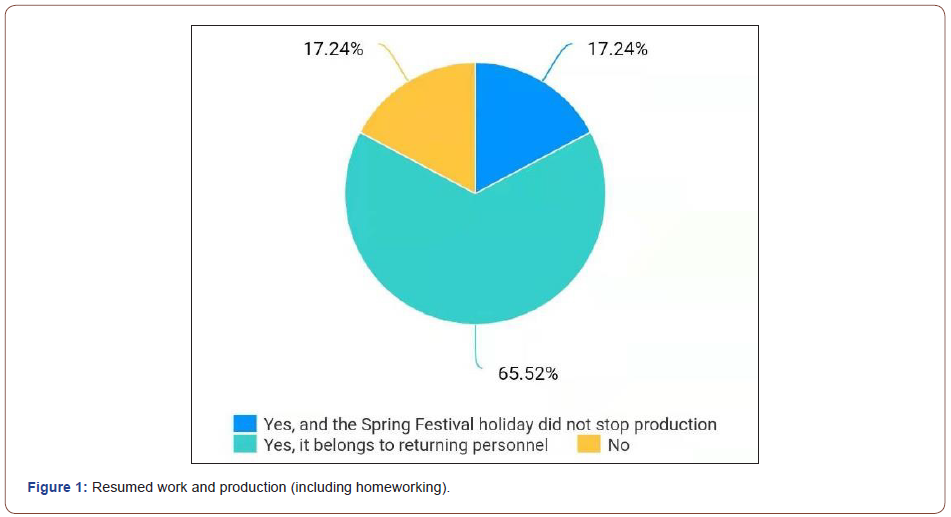
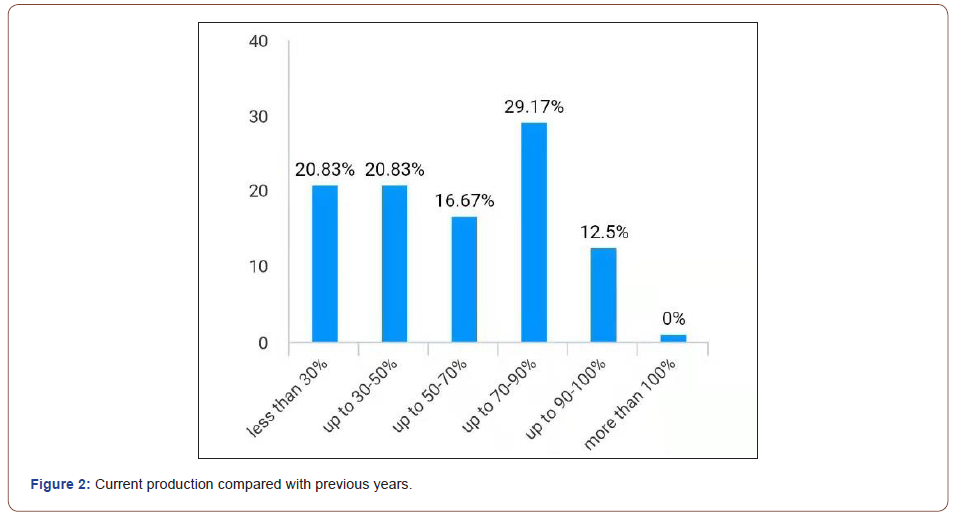
Major difficulties
In order to promote the progress of construction projects and reduce the impact of the COVID-19 epidemic on enterprises (Figure 3), most road and bridge enterprises arranged for their employees to return to work on the premise of epidemic prevention and control. Even so, there were still many difficulties in resuming work and production (Figure 4).

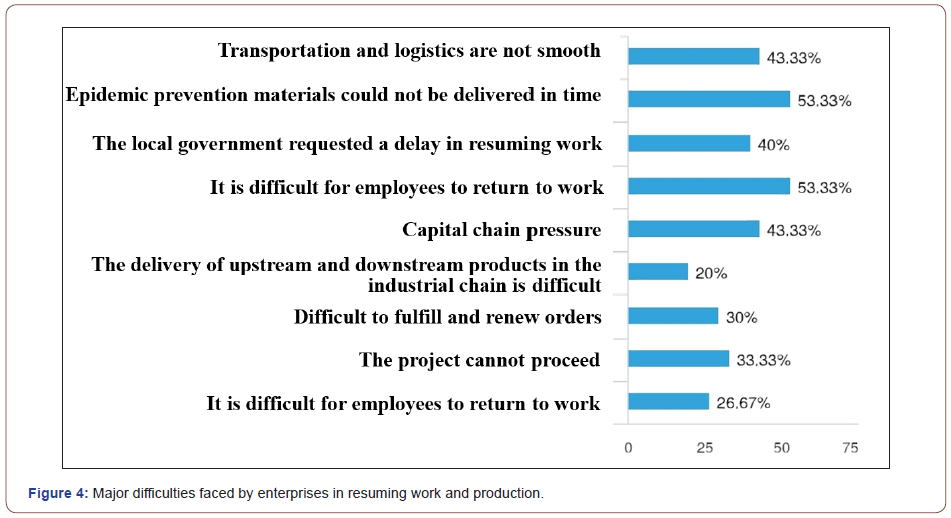
Difficulty in transporting supplies: Traffic and logistics were not smooth, which was a major problem for enterprises in resuming work and production. Since January 23, different degrees of interprovincial road closures and traffic control measures have been taken across the country, but the transportation and logistics system has not been fully restored. These various measures increase the transportation cost, time cost, management cost and the cost of coordination between different businesses [10]. They also make it difficult for employees from other provinces to return to work.
Difficulty in the timely allocation of supplies: Chinese enterprises currently face difficulties in the timely allocation of goods. This is not only due to the increased difficulty in transporting supplies and goods, but also due to the difficulty in purchasing disinfectants, protective clothing and other protective equipment, and especially disposable medical masks which are controlled by the government. Currently, some companies only have enough supplies to resume work partially.
Capital chain pressure: During to the shutdown period, employee wages, taxes and electricity fees, etc., all must continue to be paid on time. This coupled with incomplete projects that do not result in a return on investment, all contribute to businesses’ capital chain pressures. Some businesses cannot turn-over their capital and will run into other problems. Even though the state has implemented and supports policies such as “Notice on Work Related to Helping Resume Work and Overcome Difficulties in Response to COVID-19”, many enterprises have yet to enjoy them, and some are not ever aware of relevant local policies.
Measures taken to resume work and production
Epidemic control measures: In order to ensure the health of employees and prevent the spread of the COVID-19 epidemic, road and bridge enterprises have taken a series of epidemic prevention and control measures (Figure 5). In addition, some of them also launched knowledge training to increase the effectiveness of these prevention and control policies.
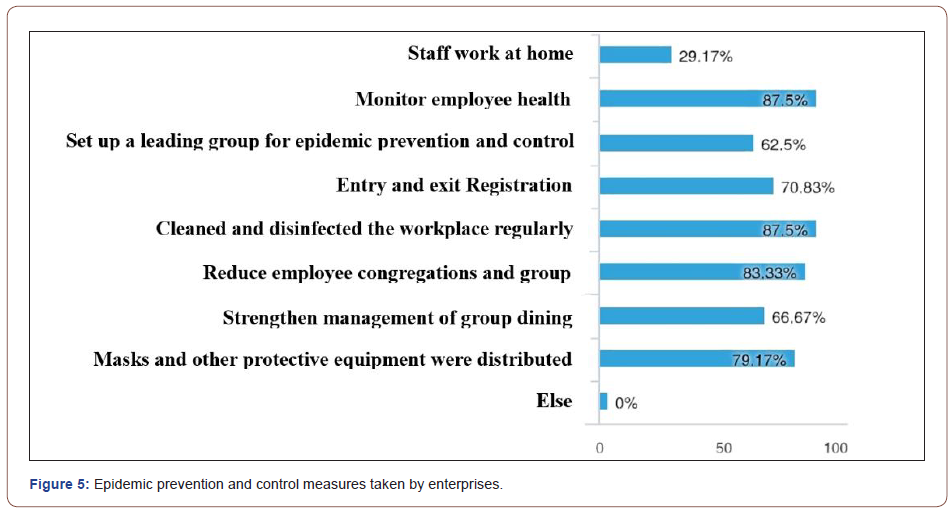
Relevant adjustment of enterprises: Under the impact of the COVID-19 epidemic, road and bridge enterprises have been unable to complete projects that have already been started. Additionally, the construction of many domestic projects has been wholly suspended due to the epidemic. Some businesses were forced to postpone the construction of key projects, seriously affecting the further development of these businesses. Others were faced with a fight for survival and took additional measures regarding salary reduction or even staff reduction. Still others were forced to shut down entire production lines due to financial problems (Figure 6).

Relevant Suggestions
For the current situation
In the face of the COVID-19 epidemic, the top priority of a business is to promote the construction of road and bridge projects under the premise of epidemic prevention and control, ensuring the quality of the project, completing projects as soon as possible, and minimizing the impact of the epidemic on the business. Secondly, we should turn our attention to the internal culture of the business by improving the psychological condition of the construction staff to improve the quality of construction projects. At the same time, brand strategy can be enhanced to increase the visibility of the business, attract talented employees, and to lay a foundation for the future development of the business.
For future development
With the gradual integration of China’s road and bridge construction industry into the global economy and the gradual opening of the road and bridge construction markets, businesses face a much bigger potential market while competing with foreign road and bridge construction enterprises. The enhancement of an enterprise’s core competitiveness is the basis for the development and growth of an enterprise. Facing the trend of diversification, road and bridge enterprises can transform from a single-contract project model into a comprehensive business, combining production as well as capital operation, by way of integrating a developmenttype business model with construction and production, providing a business with multiple avenues to bring in money.
Of course, expansion and development are worth encouraging, but construction should still be the core business of road and bridge enterprises. The active development of construction technologies and the implementation of this research and development are also extremely important for a business to gain a firm foothold in the road and bridge industry.
Conclusion
In sum, the successful development of road and bridge enterprises cannot now do without correct and effective epidemic prevention and control measures, high-technology engineering arrangements, and comprehensive construction plans. Road and bridge enterprises, among others, are responsible for the spread of infectious diseases such as COVID-19. Therefore, major road and bridge businesses should correct their attitudes, pay due diligence to the potential spread of various infectious diseases and make timely adjustments to construction plans of important projects. The state should also increase the requirements for epidemic prevention during the construction of various construction projects so that the transmission of various infectious diseases can be halted as soon as possible. Employees of road and bridge enterprises should also be knowledgeable of epidemic prevention and take safety measures during construction work.
Through the COVID-19 epidemic, many road and bridge enterprises have accumulated valuable experiences in dealing with infectious diseases, and China has once again shown the world its miraculous speed and organization. We also learned a lot relating to our area of study, such as the importance of the road and bridge industry and the construction industry in general to China’s economic and infrastructural development.
We believe, after concluding our research, that China’s road and bridge industry will continue to grow. These businesses will continue to improve China’s infrastructure, provide more convenient transportation, and promote the development of China’s socio-economic values for the growth of China’s comprehensive national strength.
Acknowledgment
This research is supported by the project of “High Education funding of Guangdong Province: 2018KZDXM072”; the College Students’ Innovation and Entrepreneurship Project: 5031700602O6; the Natural Science Foundation of Guangdong Province: 2021A1515010704; Guangdong Province Ordinary Universities Characteristic Innovation Project(2020KTSCX152); the National Natural Science Foundation of China(41702323); College Student Innovation and Entrepreneurship Program for Wuyi University(2020CX10); Doctoral Scientific Research Foundation of Wuyi University(5041700131);
Conflict of Interest
No conflict of interest.
References
- Sina Finance (2020) CCTV News: The Incubation Period of the New Virus is Infectious, and the Current Epidemic has Entered a More Serious and Complex Period [EB/OL].
- Hubei Provincial People's Government Website (2020) Circular of Wuhan Novel Coronavirus Pneumonia Prevention and Control Headquarters [Z].
- The State Council (2020) Guidelines for the Prevention and Control of New Coronary and Coronary Pneumonia in the Prevention and Control of Precision [Z].
- Tianjin Housing and Rural Construction Committee (2020) the City and Rural Construction Committee is Informed of the Problem of the Prevention and Control of the Outbreak of Construction in Our City [Z].
- Zhao Tianyu (2020) Similarities and Differences Between COVID-19 and SARS Pneumonia [N]. China Digital Science and Technology Museum Beijing Science and Technology News.
- China News (2020) The State Council Information Office Held a Press Conference on the Novel Coronavirus Pneumonia Prevention and Control Work [Z/OL].
- Chen Chunjie (2007) Development Strategy of Large and Medium-Sized Road and Bridge Construction Enterprises [D]. Tianjin University.
- Tianjin University (2013) Discussion on Market Demand and Development Trend of Bridge Engineering in China [J]. Modern Trade and Industry 25(23): 75-76.
- He Guoxiao (2018) Present Situation and Development Trend of Road Engineering Construction Technology [J]. Horizon of Science and Technology 36: 114-115.
- Research Group of China Enterprise Confederation (2020) China's Top 500 Manufacturers Resume Work and Production with 97% and Capacity Utilization Rate of Nearly 60% [N]. 21st Century Business Herald, (009).
-
Jiefang Huang, George Zhuang , Chao Yang and Jiujiang Zhu. Workplace Epidemic Prevention and Control and Return to Work Measures and Difficulties, Based on a Questionnaire Survey Analysis of Employees in the Road and Bridge Industry. Glob J Eng Sci. 9(1): 2022. GJES.MS.ID.000710.
-
Epidemic prevention and control, Road and bridge enterprises, Difficulties in resuming work and production
-

This work is licensed under a Creative Commons Attribution-NonCommercial 4.0 International License.






